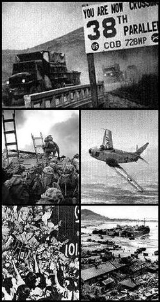
1950 The Korean War begins with the invasion of South Korea by North Korea.
1950 The United States decides to send troops to fight in the Korean War.
1950 Korean War: ask Force Smith
1950 Korean War: North Korean troops initiate the Battle of Taejon.
1950 Korean War: United States forces land at Inchon
1950 Korean War: The First Battle of Maryang San, primarily pitting Australian and British forces against communist China, begins.
1950 Korean War: After the Chinese leadership finally settled the issue of armed intervention on October 18, the People's Republic of China joins the Korean War by sending thousands of troops across the Yalu river to fight United Nations forces.
1950 Korean War: After the Chinese leadership finally settled the issue of armed intervention on October 18, the People's Republic of China joins the Korean War by sending thousands of troops across the Yalu river to fight United Nations forces.
1950 Korean War: United States Air Force Lt. Russell J. Brown shoots down two North Korean MiG-15s in the first jet aircraft-to-jet aircraft dogfight in history.
1950 Korean War: Troops from the People's Republic of China launch a massive counterattack in North Korea against South Korean and United Nations forces (the Battle of the Ch'ongch'on River and the Battle of Chosin Reservoir), ending any hopes of a quick end to the conflict.
1950 Korean War: North Korean and Chinese troops force United Nations forces to retreat from North Korea.
1950 U.S. President Harry S. Truman declares a state of emergency, after Chinese troops enter the fight with communist North Korea in the Korean War.
1951 Korean War: Chinese and North Korean forces capture Seoul.
1951 Korean War: Battle of Chipyong-ni, which represented the "high-water mark" of the Chinese incursion into South Korea, commences.
1951 Korean War: peration Ripper
1951 Korean War: For the second time, United Nations troops recapture Seoul.
1951 Korean War: President Harry Truman relieves General Douglas MacArthur of overall command in Korea.
1951 Korean War: Armistice negotiations begin at Kaesong.
1952 Korean War: United Nations and South Korean forces launched Operation Showdown against Chinese strongholds at the Iron Triangle. The resulting Battle of Triangle Hill was the biggest and bloodiest battle of 1952.
1953 The Korean War ends when the United States, the People's Republic of China, and North Korea sign an armistice agreement. Syngman Rhee, President of South Korea, refuses to sign but pledges to observe the armistice.
1958 Memorial Day: the remains of two unidentified American servicemen, killed in action during World War II and the Korean War respectively, are buried at the Tomb of the Unknown Soldier in Arlington National Cemetery.

